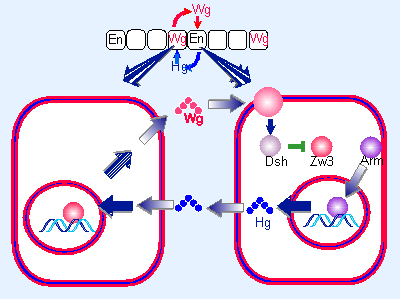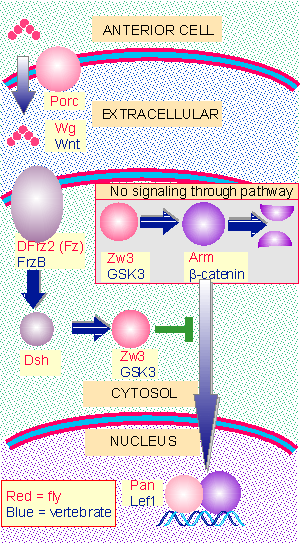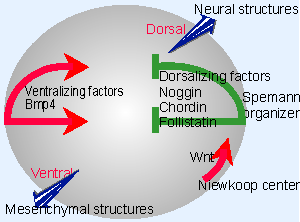12. Complex loci are extremely large and involved in regulation
29.11 The wingless/wnt signaling pathway |
The wingless signaling pathway is one of the most interesting, and has close parallels in all animal development. Like other signaling pathways utilized in development, it is initiated by an extracellular ligand, and results in the expression of a transcription factor, although the interactions between components of the pathway are somewhat unusual.
 |
Figure 29.30 Reciprocal interactions maintain Wg and Hg signaling between adjacent cells. Wg activates a receptor, which activates a pathway leading to translocation of Arm to the nucleus. This leads to expression of Hedgehog protein, which is secreted to act on the neighboring cell, where it maintains Wg expression. |
In fly embryonic development at the stage of segmental definition, the cells that define the boundaries of the A and P compartments express wingless (Wg) and engrailed (En) in a reciprocal relationship. Figure 29.30 shows that wingless protein is secreted from a cell at a boundary, and acts upon the cell on its posterior side. The wingless signaling pathway causes the engrailed gene to be expressed. Engrailed causes the production of hedgehog (Hg) protein, which in turn is secreted. Hedgehog acts on the cell on its anterior side to maintain wingless expression. Wg is also required for patterning of adult eyes, legs, and wings (hence its name) (Rijsewijk, 1987).
 |
Figure 29.31 Wg secretion is assisted by porc. Wg activates the Dfz2 receptor, which inhibits Zw3 kinase. Active Zw3 causes turnover of Arm. Inhibition of Zw3 stabilizes Arm, allowing it to translocate to the nucleus. In the nucleus, Arm partners Pan, and activates target genes (including engrailed). A similar pathway is found in vertebrate cells (components named in blue). |
Mutants in other genes that have segment polarity defects similar to wg mutants identify other components of the pathway. They signal positively to execute the pathway. Mutants in zw3 have an opposite phenotype; zw3 functions to block the pathway. Figure 29.31 shows the results of ordering the genes genetically and defining the biochemical interactions between their products.
Porc (coded by porcupine) is a transmembrane protein that is required to assist the secretion of Wg from the anterior cell. The identification of the receptor for Wg on the posterior cell has actually been very difficult. Wg interacts with frizzled in vitro, but mutational analysis suggests that the related protein, DFz2 (Drosophila frizzled-2) may be the receptor. It is possible that these may play redundant roles and/or that some other unidentified coreceptor is necessary. The frizzled family members are 7-membrane pass proteins, with the appearance of classical receptors (although the major pathway does not appear to involve G proteins) (Bhanot et al., 1995).
Whatever the details of the ligand-receptor interaction, it results in activation of Dsh (coded by Dishevelled). Dsh is a cytosolic phosphoprotein. Its detailed action is not known, but, directly or indirectly, it inhibits the Ser/Thr kinase Zw3. When Zw3 is active, it inhibits the action of the next component in the pathway, Arm (coded by Armadillo). The inhibition of Zw3 releases the action of Arm, which translocates to the nucleus. Arm binds to its partner Pan, and activates a set of target genes.
 |
Figure 29.19 Two common pathways are used in early development of Xenopus. The Niewkoop center uses the Wnt pathway to induce the Spemann organizer. The organizer diffuses dorsalizing factors that counteract the effects of the ventralizing BMPs. |
The pathway in vertebrate cells is basically the same. The ligands that trigger the pathway are members of the Wnt family (which has ~20 members). They are related to Wg. Different members of the Wnt family are expressed in different times and places in the vertebrate embryo, where the pathway is involved in patterning events. One example was shown previously in Figure 29.19, where the Niewkoop center triggers a Wnt pathway with the effect of inducing the Spemann organizer (Smith and Harland, 1991; for review see Cadigan and Nusse, 1997).
The transduction pathway has homologous components. Dsh signals to the kinase GSK3 (named for its historical identification as glycogen synthase kinase, but in fact a homologue of Zw3). GSK3 is constitutively active, but the result of Dsh’s action is to inhibit it. This allows β-catenin (the homologue of Arm) to translocate to the nucleus, where it partners the transcription factor Tcf/LEF1 (named depending on the system). The β-catenin subunit activates transcription at promoters that are bound by the Tcf subunit. The homeobox gene siamois is a major target (Molenaar et al., 1996; Brunner, 1997). (A more complete account of the pathway is available in the Connection Maps at http://www.stke.org/).
The most surprising feature of this pathway is the nature of the Arm/β-catenin protein. It has two unconnected activities. It is a component of a complex that links the cytoskeleton at adhesion complexes. β-catenin binds to cadherin. Mutations of armadillo that disrupt the cadherin-binding site show a defect in cell adhesion. A separate domain of Arm/β-catenin has a transactivation function when the protein translocates to the nucleus. Nuclear translocation appears to be a consequence of the increase in the levels of Arm/β-catenin that result from the inhibition of Zw3/GSK3. The phosphorylation of Arm/β-catenin destabilizes it, probably by making it a target for proteasomal degradation.
This signaling pathway is also implicated in colon cancer. Mutations in APC (adenomatous polyposis coli) are common in colon cancer. APC binds to β-catenin, and its usual effect is to destabilize it. The mutant proteins found in colon cancer allow levels of β-catenin to increase. Mutations in β-catenin that increase its stability have the same effect. One possibility is that APC is the direct target for GSK3, and that its phosphorylation causes it to destabilize β-catenin. However, it is not yet clear whether APC is required for morphogenetic pathways in flies and vertebrates.
| Reviews | |
| Cadigan, K. M. and Nusse, R. (1997). Wnt signaling: a common theme in animal development. Genes Dev. 11, 3286-3305. | |
| Research | |
| Bhanot, P. et al. (1995). A new member of the frizzled family from Drosophila functions as a wingless receptor. Nature 382, 225-230. | |
| Brunner, E. (1997). pangolin encodes a Lef-1 homologue that acts downstream of Armadillo to transduce the Wingless signal in Drosophila. Nature 385, 829-833. | |
| Molenaar, M. et al. (1996). XTcf-3 transcription factor mediates &#szlig;-catenin-induced axis formation in Xenopus embryos. Cell 86, 391-399. | |
| Rijsewijk, F. M. (1987). The Drosophila homolog of the mouse mammary oncogene int-1 is identical to the segment polarity gene wingless. Cell 50, 649-657. | |
| Smith, W. C. and Harland, R. M. (1991). Injected Xwnt-8 RNA acts early in Xenopus embryos to promote formation of a vegetal dorsalizing center. Cell 67, 753-765. | |